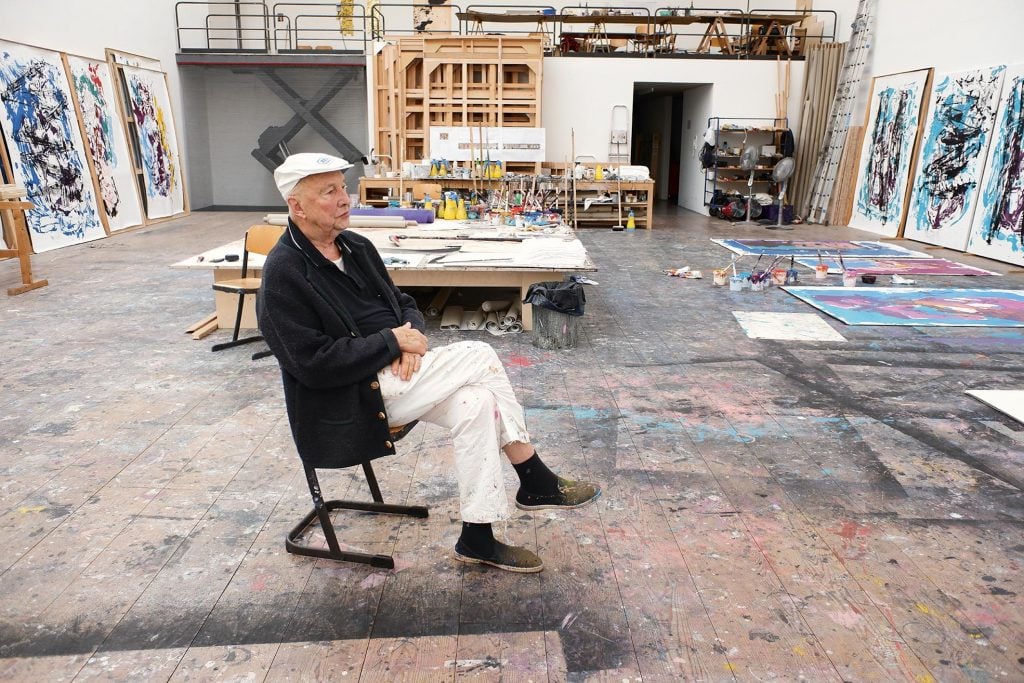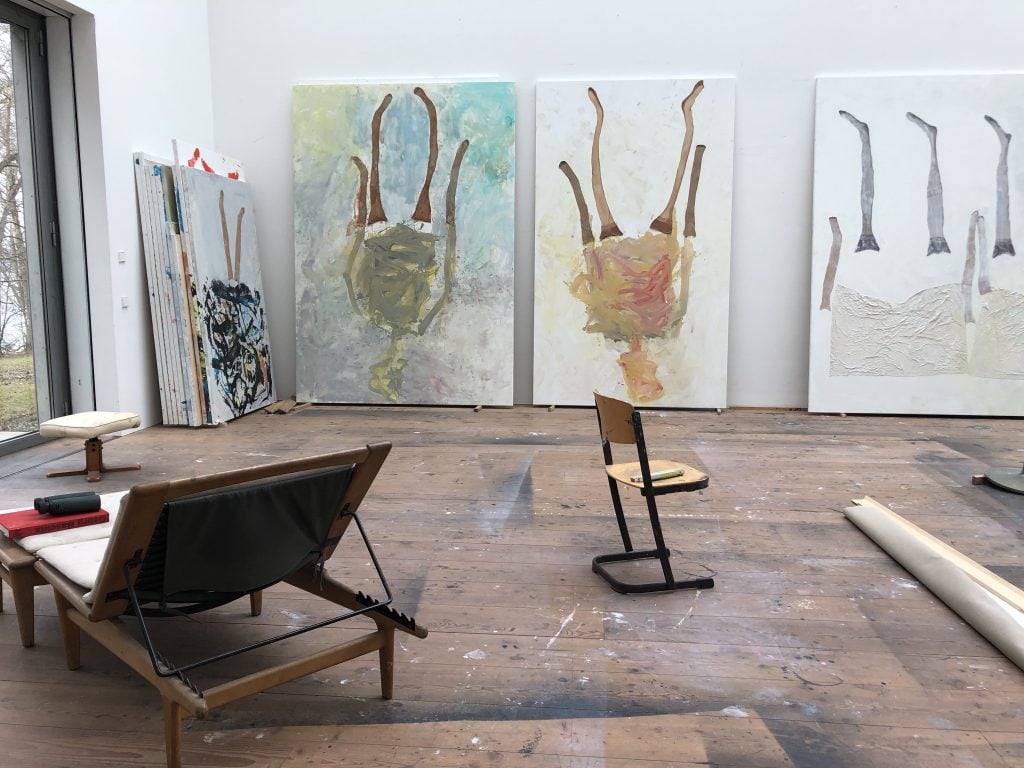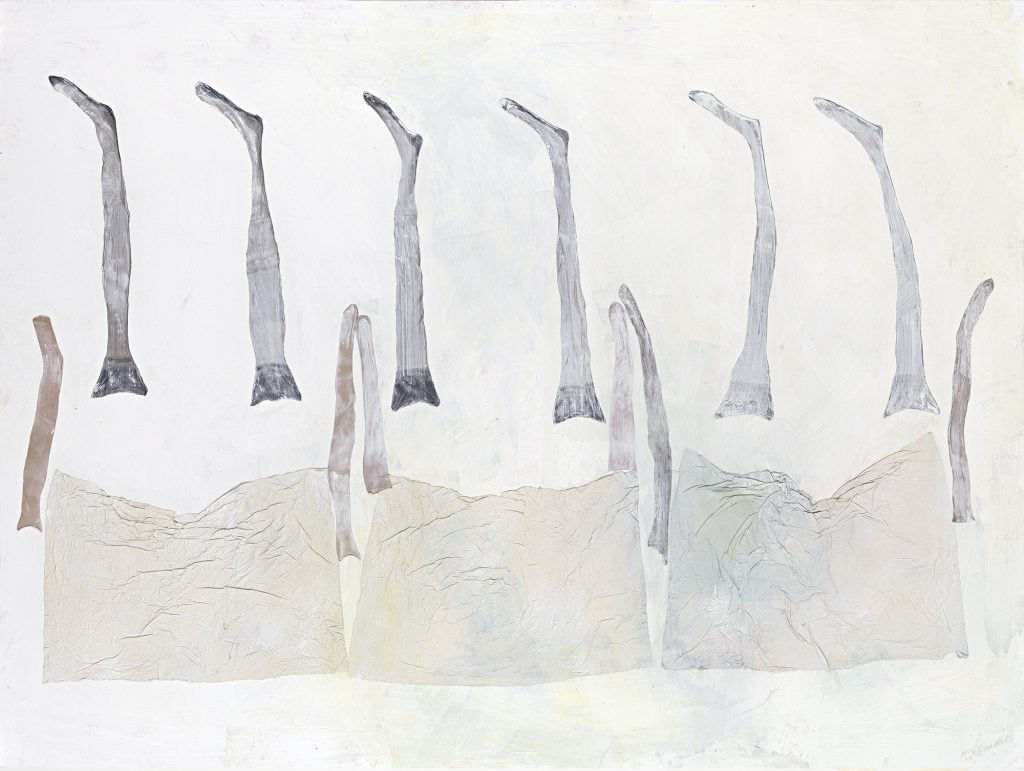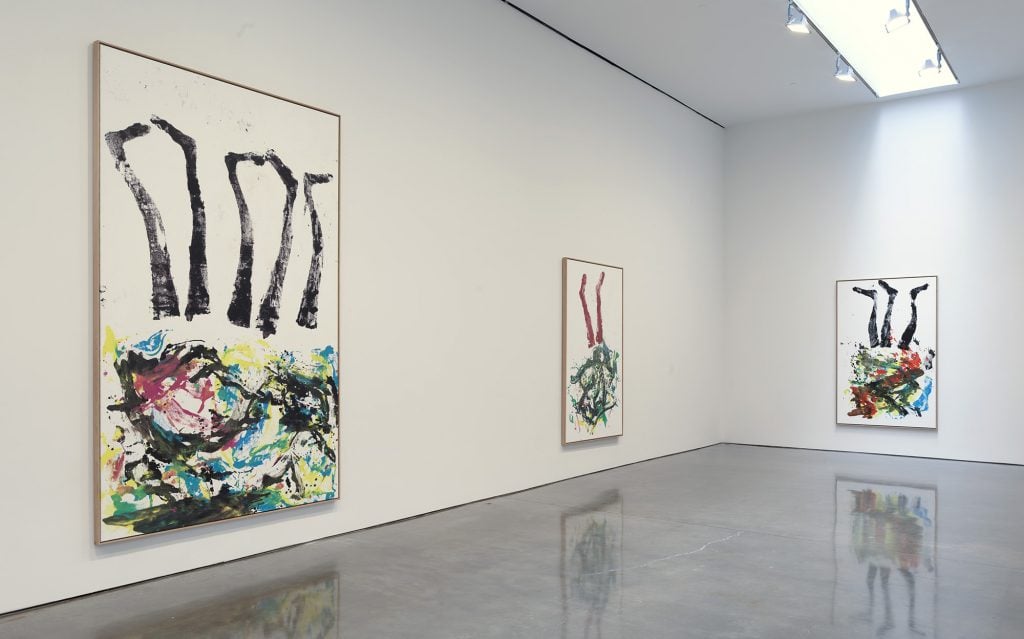People
Painter Georg Baselitz on Why He Thinks the Art World Is Living in a ‘Quota-ocracy,’ and What It Really Takes to Be a Great Artist
We caught up with the 83-year-old painter as he debuted new works in Venice and New York.

We caught up with the 83-year-old painter as he debuted new works in Venice and New York.

Naomi Rea

Georg Baselitz has been stirring up controversy for over half a century. The artist, who is now 83, was the subject of an obscenity trial in the 1960s over his painting of a young boy holding an exaggerated phallus. He later showed wooden figures appearing to give Nazi salutes at the 1980 Venice Biennale, and more recently he made comments in the press casting aspersions on the abilities of women artists.
When I caught up with him, the artist was in Venice for the opening of an exhibition of new work in the majestic setting of the Museo di Palazzo Grimani. Meanwhile, in New York, he was debuting at Gagosian another new series of his inverted works—the upside-down figures he’s been painting since 1969—this time featuring nylon stockings.
Baselitz was not entirely repentant for his past remarks about women when we spoke, although he categorized some of it as a “misunderstanding.” He also made new provocations, sharing his disappointment that the art world is more concerned with “quotas” than artistic talent these days, and why he thinks Germany has become a “cultural wasteland.”

Ammersee, Germany, 2020. Photo: © Elke Baselitz 2021. Courtesy Gagosian.
Let’s talk about your current exhibition at Gagosian, “Springtime.” How long have these works been in progress? And how have you been spending your time during lockdown?
I have been working like the devil. I started working on the pictures now on exhibition in New York in October 2020.
Were they a response to the pandemic?
Thinking about this question, I remembered Hanna Höch and the funny Dada period in Germany, which at that time was in poor condition. During this period of upheaval, people used to make fun of situations by applying and integrating confusing and irritating things. Quite similar to today actually, in these dreary times. However, the art of that time does not picture melancholy—it comes across as light and aggressive.
In this exhibition, you have introduced a new element to your practice—collage—and a very interesting choice of materials in nylon stockings. Why were you drawn to them as a material and subject matter?
I mentioned Hanna Höch because she was—during the Dada era—bustling and seditious. At that time, painting was left behind and people started making collages. One of these collages was a most wonderful one of female legs crowned with an African mask. This piece is an icon of its time and one that took possession of me.
However, I did not want to make pictures arranged of strange elements glued together. I wanted to stick to my own type of picture and to alienate it by adding a peculiar ingredient. Hence, I now draw ugly legs and veil them in pretty stockings.

Georg Baselitz, Spaziergang am Meer (2021). Georg Baselitz 2021. Photo: Jochen Littkemann, Berlin. Courtesy Gagosian.
You have titled several of the paintings in reference to women artists, including Helen Frankenthaler, Sarah Lucas, and Kiki Smith. What is your connection to these women, and why the homage?
One of pictures is titled Springtime at the Black Mountain Lake. This is the origin of the title for the exhibition. With “Black Mountain,” I am referring to the college at which [John] Cage and [Robert] Rauschenberg studied. Rauschenberg created some very crucial paintings there, like the black and white ones, all of them carrying a secret, not in the sense of Malevich’s Black Square, but a mystery that can be deciphered psychologically and perhaps even literarily. The titles of my pictures in this exhibit are an homage to these different artists that I busy myself with.
No one has forgotten that 2013 interview you did with Der Spiegel in which you said that you did not think that women make for very good painters. Has your view on this matter changed?
That was one of my provocations that was cited out of context and led to misunderstandings. I find it utterly stupid to classify art by quotas: male, female, Black, white … for me there is only good or bad art. Of course we can observe that, as for example, a daughter—Artemisia Gentileschi—painted better than her father. Also thinking in more recent terms, there is stunning art from Sarah Lucas, Tracey Emin, Cecily Brown, and others.
I really do not think that we have become a better, more harmonious society because of this. But I do still think that you need a very strong will, to a point that can endanger one’s own existence, to establish novelty in art.
What do you mean by a will that can “endanger one’s own existence?” Do you think it is more common for male artists to be able to demonstrate this strong will and willingness for confrontation?
Nietzsche says “talent asserts itself by struggling.” If you compromise at the beginning and join the mainstream, you might feel better, but the result, the art you make, becomes mainstream. That’s regardless of whether you are a man or a woman.

“Spingtime,” 2021, installation view. ©Georg Baselitz. Photo by Rob McKeever. Courtesy Gagosian.
Earlier this year, you and your wife Elke gifted six of your early “inverted” paintings to the Metropolitan Museum of Art. Can you tell me about what motivated the gift?
Before they’d gone to the Metropolitan Museum of Art these pictures were exhibited on a continuous loan basis in Dresden, where they could well have remained according to our opinion.
However, great changes have been taking place in Germany, which have in a short period of time led to a German cultural wasteland. One of the people to blame for this is Monika Grütters, the German culture minister. According to her, “art belongs in the care of the state and not under the hammer.” Based on this belief, she released a Culture Protection Act which grants the state access rights to specific works of art. This reminds me of the 1930s. My family and I have withdrawn by gifting the paintings to the Met—also in thankfulness to America, the land that has always represented freedom for us.
The gifted works came from your personal collection. What else is in that collection—of your own work, but also any work by other artists?
One should not forget that these gifted pictures were misjudged and not sought after at all for quite some time. When on show for the first time, nobody noticed and whoever did thought they were a joke. Nobody really understood the personal risk I took by inverting motifs. At the time, I tried to create a simple, modest, non-political visual appearance of low furore and drama. That made these pictures a little lonely for many years, remaining in my possession.
In terms of the art that I like to surround myself with, one has to understand that I have always lived a rather secluded life in the country. I have, for this reason, always strived to surround myself with documents that I need for my intellect. This forms the basis of my collection, which entails the old masters of Mannerism, African Art, and pieces by artists I admire such as Fontana, Vedova, Warhol, Lichtenstein, Lundquist, Rauschenberg, and so on.
You have cited the work of Philip Guston as having been a key influence on you. What did you make of the postponement of his retrospective at the National Gallery in Washington D.C., following the controversy surrounding some of his works depicting members of the Ku Klux Klan?
Philip Guston’s pictures are fantastic. I first saw them in 1958 as a student at my school in Berlin. This exhibition—today we know that it was financed by the CIA to show the German public what culture is—was incredibly impressive and had a great impact on my later oeuvre. I understood the signals very well at the time. Today I find it utterly unacceptable for people to interfere and decide which art can be shown and which art cannot be shown.

Georg Baselitz, “Archinto” 2021. Installation view. ©Georg Baselitz. Photo by Matteo De Fina. Courtesy Gagosian.
Your own provocative work has also stirred up various polemics in your time—from charges of obscenity for being overly erotic to impropriety for evoking some of the ugly history of World War II. How do you feel the world has changed in the way it evaluates art?
There were years of wonderful experimenting. There was a small group that did art and an elite group that was interested in art. There was the combat between the abstract and the realistic. People fought over who had the better idea. It was a meritocracy. Today we live in a “quota-ocracy,” in a Robin Hood-type culture. Quality is no longer the priority but the search for the deprived of rights, the discriminated, or the forgotten.
Who loses out, in your mind, in this scenario? Artists, the public? What do you envision as the legacy of a “quota-ocracy”?
Both artists and the public will lose. And this not only applies to arts, but to all disciplines. If we do not take the principle of meritocracy into account, this can harm our society in all areas.
Behind you, you have a long and rich career. Ahead, a slate of major exhibitions in Paris and Venice, and the publication of a new monograph. What about beyond that? As you get older, how have you been thinking about your artistic legacy?
I have created an immense panopticon of pictures and still insist on holding the reins in order to find ways of improvement and in order to develop. What I mean to say is that I am not getting lazy. I work, do my nonsense, and refuse to rest!
“Georg Baselitz: Springtime” is on view at Gagosian in New York through June 12.
“Georg Baselitz: Vedova Accendi la Luce” is on view at Fondazione Vedova in Venice through October 21.
“Georg Baselitz: Archinto” is on view at Museo di Palazzo Grimani in Venice through November 27, 2022.